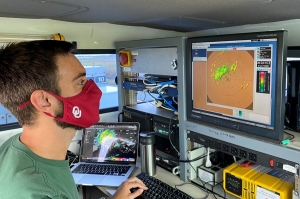NORMAN, OKLA. – As Hurricane Delta lumbers toward the Central Louisiana coast, the University of Oklahoma’s Shared Mobile Atmospheric Research and Teaching radar team, in collaboration with National Oceanic and Atmospheric Administration’s National Weather Service, is deploying a mobile weather radar to the area around Lake Charles, Louisiana.
The Lake Charles NEXRAD operated by the National Weather Service remains inoperable after suffering significant damage due to Hurricane Laura in late August. OU’s SMART radar will provide additional radar coverage for NOAA's National Weather Service forecasters issuing life-saving forecasts and warnings during the landfall of Hurricane Delta, especially in the event of critical communications infrastructure failures.
“Our nationwide network of NEXRAD radars provides overlapping coverage. To have this opportunity to provide additional radar data is a bonus for forecasters and others monitoring Hurricane Delta,” said Steven Cooper, director of the National Weather Service Southern Region. “We’re fortunate to have the relationship between all parties involved that allows this type of cooperation.”
The SMART radars are operated by the NOAA-OU Cooperative Institute for Mesoscale Meteorological Studies. Through a partnership with AT&T and The Weather Channel, the SMART radar data will be distributed in real-time and made available to local Weather Service Offices, the National Hurricane Center, emergency management, and to the general public via an open-access website. Michael Biggerstaff, OU School of Meteorology professor, leads the SMART radar team.
“The SMART radars have helped build a strong collaborative research program between university scientists and our NOAA partners, including the National Severe Storms Laboratory and the Hurricane Research Division,” Biggerstaff said. “We will do our best to augment the existing radar coverage in the vicinity of the landfall of Hurricane Delta.”
NOAA’s Radar Operations Center, located in Norman, is responsible for the life-cycle support and maintenance of our nation’s NEXRAD data.
“With the outage of the Lake Charles NEXRAD, it is great to collaborate with our colleagues at the University of Oklahoma to provide valuable supplemental weather data to NWS forecasters and decision-makers during this unprecedented hurricane season,” said Terrance Clark, Radar Operations Center director.
The weather data are available at http://smartr.metr.ou.edu/smartr2/latest/



